Attached files
| file | filename |
|---|---|
| 8-K - FORM 8-K - KBS Real Estate Investment Trust II, Inc. | kbsrii8k-webinaraug2020.htm |
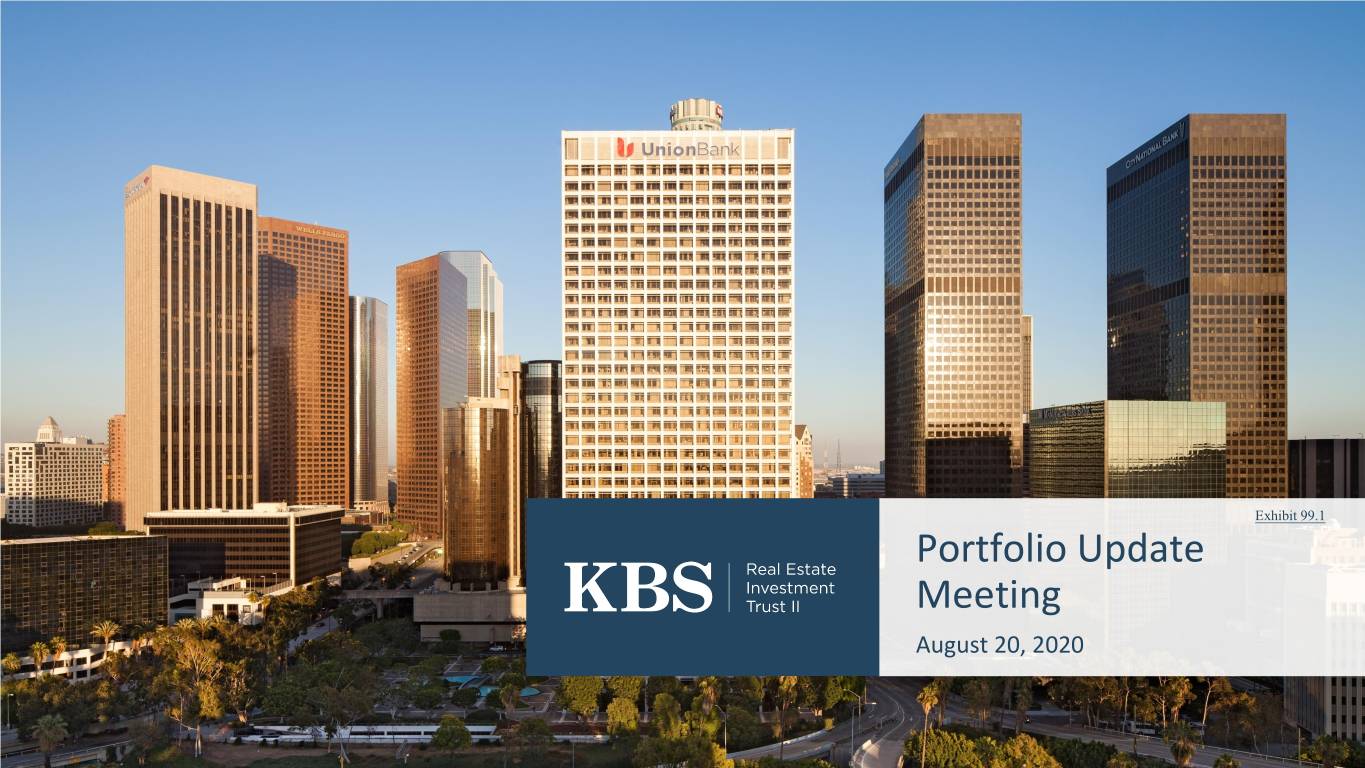
Exhibit 99.1 Portfolio Update Meeting August 20, 2020 1

The information contained herein should be read in conjunction with, and is qualified by, the information in KBS Real Estate Investment Trust II’s (the “Company” or “KBS REIT II”) Annual Report on Form 10-K for the year ended December 31, 2019 (the “Annual Report”), and in the Important Company’s Quarterly Report on Form 10-Q for the period ended June 30, 2020 (the “Quarterly Report”), including the “Risk Factors” contained Disclosures therein. Forward-Looking Statements Certain statements contained herein may be deemed to be forward-looking statements within the meaning of the Federal Private Securities Litigation Reform Act of 1995. The Company intends that such forward-looking statements be subject to the safe harbors created by Section 21E of the Securities Exchange Act of 1934, as amended. These statements include statements regarding the intent, belief or current expectations of the Company and members of its management team, as well as the assumptions on which such statements are based, and generally are identified by the use of words such as “may,” “will,” “seeks,” “anticipates,” “believes,” “estimates,” “expects,” “plans,” “intends,” “should” or similar expressions. Readers are cautioned not to place undue reliance on these forward-looking statements, which speak only as of the date they are made. The Company undertakes no obligation to update or revise forward-looking statements to reflect changed assumptions, the occurrence of unanticipated events or changes to future operating results over time, unless required by law. Such statements are subject to known and unknown risks and uncertainties which could cause actual results to differ materially from those contemplated by such forward-looking statements. The Company makes no representation or warranty (express or implied) about the accuracy of any such forward-looking statements. These statements are based on a number of assumptions involving the judgment of management. You should interpret many of the risks identified in this presentation, in our Annual Report and in our Quarterly Report as being heightened as a result of the ongoing and numerous adverse impacts of the COVID-19 pandemic. WWW. KBS.COM 2

Forward-Looking Statements Important On November 13, 2019, the Special Committee and board of directors of KBS REIT II unanimously approved the sale of all of KBS REIT II’s assets and its dissolution pursuant to the terms of KBS REIT II’s plan of complete liquidation and dissolution (the “Plan of Liquidation”). The principal Disclosures purpose of the Plan of Liquidation is to provide liquidity to stockholders by selling KBS REIT II’s assets, paying its debts and distributing the net proceeds from liquidation to stockholders. On March 5, 2020, KBS REIT II’s stockholders approved the Plan of Liquidation. For more (cont.) information, see the Plan of Liquidation, which is included as an exhibit to the Annual Report. There are many factors that may affect the amount of liquidating distributions ultimately paid to KBS REIT II’s stockholders, including, among other things, the ultimate sale price of each asset, changes in market demand for office properties during the sales process, the amount of taxes, transaction fees and expenses relating to the liquidation and dissolution, and unanticipated or contingent liabilities that could arise. No assurance can be given as to the amount or timing of liquidating distributions KBS REIT II will ultimately pay to its stockholders. If KBS REIT II underestimated its existing obligations and liabilities or if unanticipated or contingent liabilities arise, the amount of liquidating distributions ultimately paid to KBS REIT II’s stockholders could be less than estimated. The COVID-19 pandemic, together with the resulting measures imposed to help control the spread of the virus, including quarantines, “shelter in place” and “stay at home” orders, travel restrictions, restrictions on businesses and school closures, has had a negative impact on the economy and business activity globally. The extent to which the COVID-19 pandemic impacts the Company’s operations and those of its tenants and the Company’s implementation of the Plan of Liquidation, depends on future developments, which are highly uncertain and cannot be predicted with confidence, including the scope, severity and duration of the pandemic, the actions taken to contain the pandemic or mitigate its impact, and the direct and indirect economic effects of the pandemic and containment measures, among others. If tenants default on their rent and vacate, the ability to re-lease this space is likely to be more difficult if the economic slowdown continues and any long term impact of this situation, even after an economic rebound, remains unclear. Given the uncertainty and current business disruptions as a result of the outbreak of COVID-19, the Company’s implementation of the Plan of Liquidation may be materially and adversely impacted and this may have a material effect on the ultimate amount and timing of liquidating distributions received by stockholders. WWW. KBS.COM 3
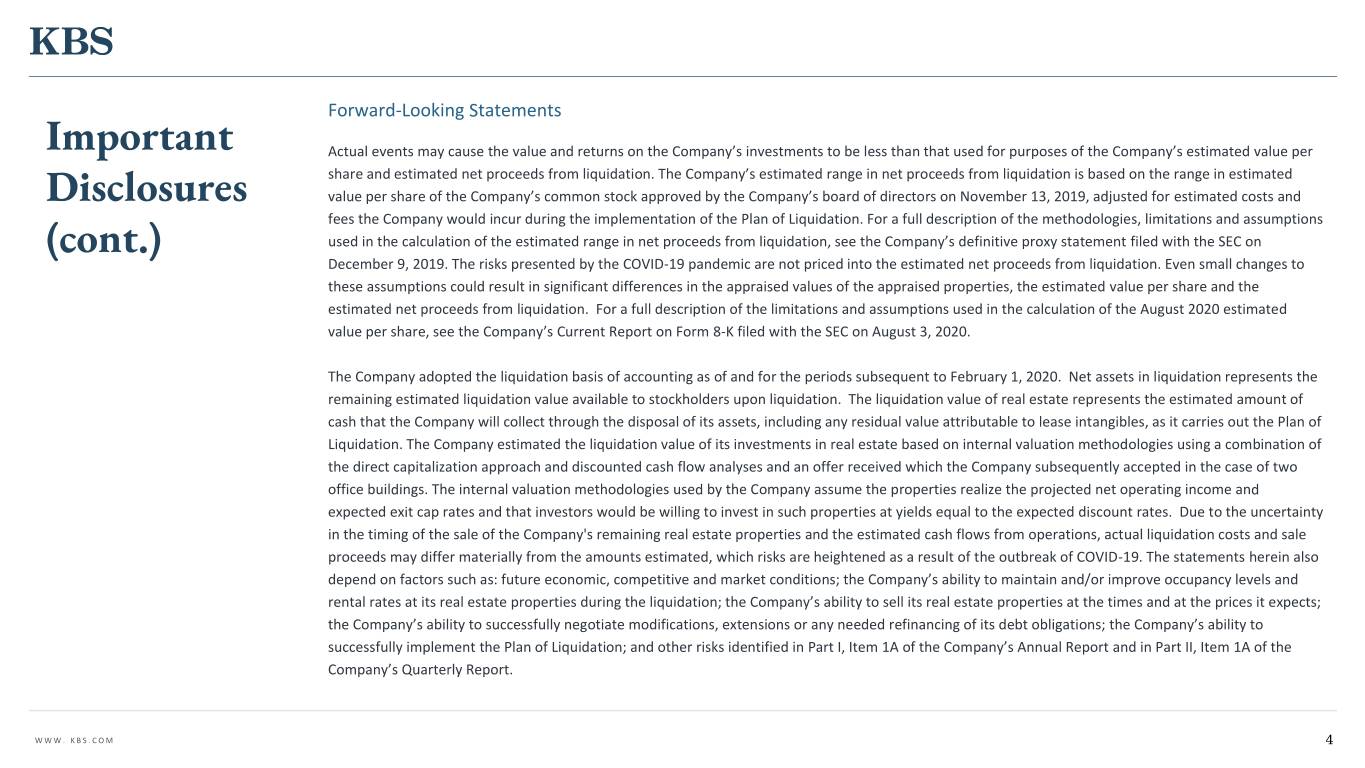
Forward-Looking Statements Important Actual events may cause the value and returns on the Company’s investments to be less than that used for purposes of the Company’s estimated value per share and estimated net proceeds from liquidation. The Company’s estimated range in net proceeds from liquidation is based on the range in estimated Disclosures value per share of the Company’s common stock approved by the Company’s board of directors on November 13, 2019, adjusted for estimated costs and fees the Company would incur during the implementation of the Plan of Liquidation. For a full description of the methodologies, limitations and assumptions (cont.) used in the calculation of the estimated range in net proceeds from liquidation, see the Company’s definitive proxy statement filed with the SEC on December 9, 2019. The risks presented by the COVID-19 pandemic are not priced into the estimated net proceeds from liquidation. Even small changes to these assumptions could result in significant differences in the appraised values of the appraised properties, the estimated value per share and the estimated net proceeds from liquidation. For a full description of the limitations and assumptions used in the calculation of the August 2020 estimated value per share, see the Company’s Current Report on Form 8-K filed with the SEC on August 3, 2020. The Company adopted the liquidation basis of accounting as of and for the periods subsequent to February 1, 2020. Net assets in liquidation represents the remaining estimated liquidation value available to stockholders upon liquidation. The liquidation value of real estate represents the estimated amount of cash that the Company will collect through the disposal of its assets, including any residual value attributable to lease intangibles, as it carries out the Plan of Liquidation. The Company estimated the liquidation value of its investments in real estate based on internal valuation methodologies using a combination of the direct capitalization approach and discounted cash flow analyses and an offer received which the Company subsequently accepted in the case of two office buildings. The internal valuation methodologies used by the Company assume the properties realize the projected net operating income and expected exit cap rates and that investors would be willing to invest in such properties at yields equal to the expected discount rates. Due to the uncertainty in the timing of the sale of the Company's remaining real estate properties and the estimated cash flows from operations, actual liquidation costs and sale proceeds may differ materially from the amounts estimated, which risks are heightened as a result of the outbreak of COVID-19. The statements herein also depend on factors such as: future economic, competitive and market conditions; the Company’s ability to maintain and/or improve occupancy levels and rental rates at its real estate properties during the liquidation; the Company’s ability to sell its real estate properties at the times and at the prices it expects; the Company’s ability to successfully negotiate modifications, extensions or any needed refinancing of its debt obligations; the Company’s ability to successfully implement the Plan of Liquidation; and other risks identified in Part I, Item 1A of the Company’s Annual Report and in Part II, Item 1A of the Company’s Quarterly Report. WWW. KBS.COM 4

The Impact of COVID-19 on Capital Markets and US Real Estate Investments WWW. KBS.COM 5

COVID-19:The Economy • The Department of Commerce reported that U.S. gross domestic product (GDP), the broadest measure of the nation's economic output, fell by an annualized rate of 5% in the first quarter followed by an even steeper decline of 33% in the second quarter based on initial estimates. Almost 13 million jobs were lost in the second quarter, despite strong job gains in May and June. 1 • On the whole, the US Office market remains relatively resilient, though not immune to the economic downturn. The US shed about 4 million office-using jobs between the first and second quarters, but a far cry from the 40 million-plus jobless claims filed since mid-March. 1 • As restrictions are substantially lifted, there is potential for a strong economic recovery taking hold in the second half of 2020 and lasting into 2021. Auto and air travel are increasing and customers are returning to those restaurants that have reopened for dining. Continued momentum will depend on further fiscal stimulus and a vaccine for COVID-19.2 1 CoStar, US Office National Report, 2Q 2020 2 CBRE, Midyear Review, Global Real Estate Market Conditions Outlook 2020 WWW. KBS.COM 6 6

• According to CoStar, the full impact of the coronavirus outbreak on the US Office COVID-19: sector remains unclear, but expectations are for a drop-off in leasing and transaction Office Market volume to continue beyond the second quarter. The vacancy rate is still below the historical average of about 11%, and well below the 13%-plus rates following the Demand Great Recession.1 • The US had strong fundamentals heading into this downturn which has mitigated some of the pain. Additionally, there hasn't been a large spike in sublease space which would compound any vacancy rate increases. 1 • Some loss of office-using employment will lower leasing demand this year, dropping absorption into negative territory. Most of the negative impacts on demand and values should be confined to this year, with the potential for a robust bounce back in 2021.2 • New supply is delivering into a stagnant leasing environment. But, many of the major projects delivering by the end of this year broke ground well before the pandemic hit and had secured significant pre-lease commitments. 1 1CoStar, U.S. Office National Report, 2Q 2020 2CBRE, Midyear Review, Global Real Estate Market Conditions Outlook 2020 WWW. KBS.COM 7

• The office market likely will see several quarters of subdued activity until a clearer timeline for reopening COVID-19: appears and a vaccine is developed. This will allow occupiers to effectively plan reopening of workplaces and accurately forecast future needs. CBRE projects that a recovery for most commercial real estate Office Market – the sectors—aside from industrial and multifamily—will not start in earnest until 2021. A full recovery of office demand is not expected until late 2022, and not until 2024 for retail. Hotels should see a full recovery in Road to Recovery demand by late 2023.1 • A recovery is already underway, aided by an unprecedented level of fiscal and monetary stimulus, as well as pent-up demand. The recession is expected to depress interest rates for at least two years, which could support capital flows to commercial real estate. Companies likely will wait until the economic recovery appears firm and sustainable before they lease more space, meaning that a recovery for commercial real estate could lag the economic recovery by at least six months.2 What we've seen in the course of the crisis is just the rapid growth of the digital economy, in particular, the rapid adoption of technologies around meetings. I think it just gives more scope for people working from one or two or three locations. I remain convinced that the office sector is viable in the long term. It's where people meet. It's where creativity happens. It's where clients get helped. That's where we train and bring in younger people into the workforce. And all those things are going to need to reestablish themselves. I think the office sector will bounce back."3 1 CBRE, U.S. Economic Watch, “Q2 GDP Contracts by 32.9%”, July 30, 2020 2 CBRE, Midyear Review, Global Real Estate Market Conditions Outlook 2020 Richard Barkham, CBRE Chief Global Economist 3 CBRE, Richard Barkham, CBRE Global Chief Economist, The Weekly Take, “The Outlook for Commercial Real Estate’s Recovery”, August 10, 2020 WWW. KBS.COM 8

COVID-19: • Most firms appear to be in no hurry to make major real estate decisions right now. This point is underscored by the spread between renewal deals and new deals. If tenants aren't facing an imminent Space Planning and lease expiration, real estate decisions are on the back burner.1 • The work-from-home experiment has proven technically possible, but at a potential cost to corporate Facilities culture, collaboration and innovation. A pure work-from-home approach has its drawbacks, as company culture suffers, collaboration is challenged and the chance of employee burnout increases. 2 Management • Any increase in remote-working represents a headwind to office demand, with wider ramifications in terms of location priorities for investors and occupiers, though we believe that such headwinds will be offset by the need for companies to lower workplace density long term. 2 • The need to maintain low workplace density and ensure adequate social distancing is requiring employers to institute schedules that have a combination of some employees working in the physical office and others at home.2 • An enhanced focus on health and safety is expected this year and KBS is on the forefront implementing new HVAC air cleaning and filtration systems including heavier-duty HVAC filters that block microbes. Other new concepts include UV light or electrically charged particles in the ductwork to kill the virus. KBS is helping many tenants to reconfigure spaces to maintain safer distances, management of foot flow, scheduling and sanitation protocols. • We believe office space is critical for companies not only for collaboration and results, but also in attracting and training new talent. 1CoStar, U.S. Office National Report, 2Q 2020 2CBRE, Midyear Review, Global Real Estate Market Conditions Outlook 2020 WWW. KBS.COM 9
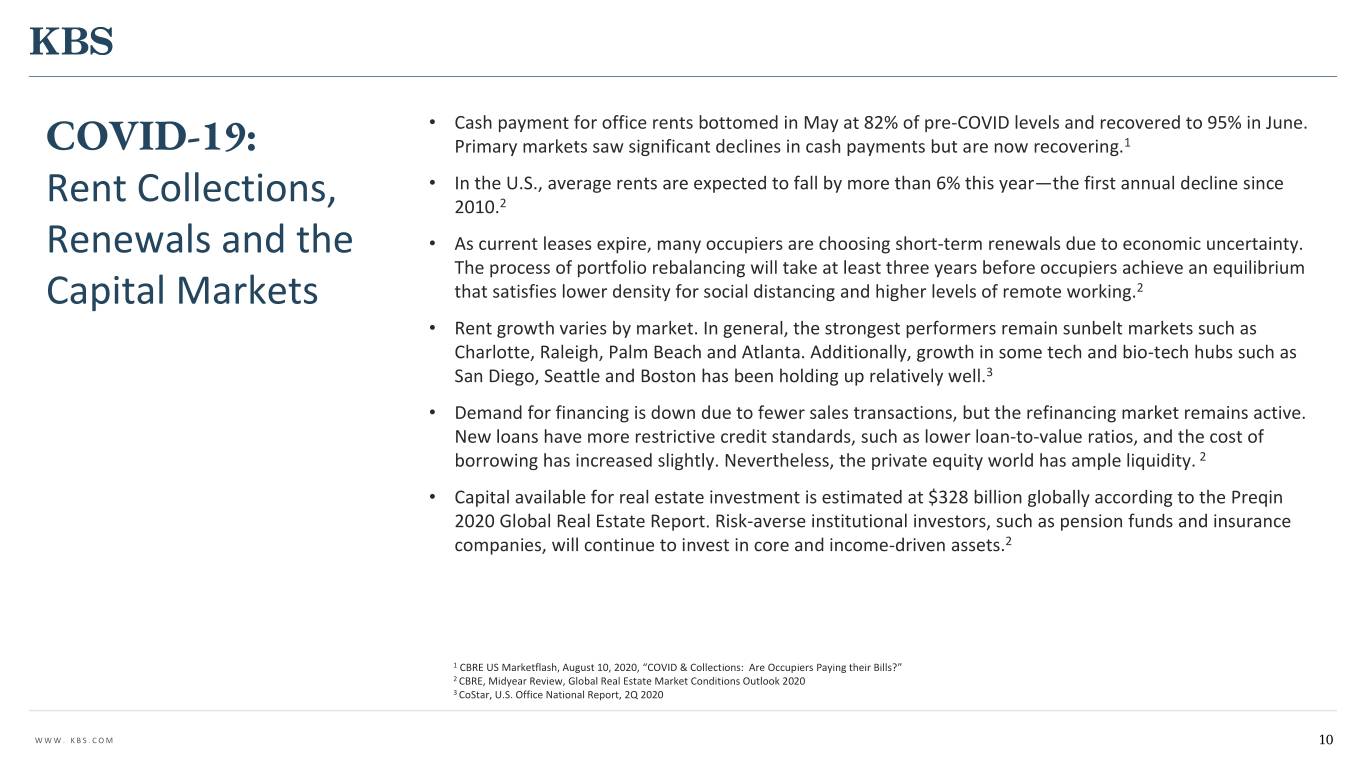
• Cash payment for office rents bottomed in May at 82% of pre-COVID levels and recovered to 95% in June. COVID-19: Primary markets saw significant declines in cash payments but are now recovering.1 • In the U.S., average rents are expected to fall by more than 6% this year—the first annual decline since Rent Collections, 2010.2 Renewals and the • As current leases expire, many occupiers are choosing short-term renewals due to economic uncertainty. The process of portfolio rebalancing will take at least three years before occupiers achieve an equilibrium Capital Markets that satisfies lower density for social distancing and higher levels of remote working.2 • Rent growth varies by market. In general, the strongest performers remain sunbelt markets such as Charlotte, Raleigh, Palm Beach and Atlanta. Additionally, growth in some tech and bio-tech hubs such as San Diego, Seattle and Boston has been holding up relatively well.3 • Demand for financing is down due to fewer sales transactions, but the refinancing market remains active. New loans have more restrictive credit standards, such as lower loan-to-value ratios, and the cost of borrowing has increased slightly. Nevertheless, the private equity world has ample liquidity. 2 • Capital available for real estate investment is estimated at $328 billion globally according to the Preqin 2020 Global Real Estate Report. Risk-averse institutional investors, such as pension funds and insurance companies, will continue to invest in core and income-driven assets.2 1 CBRE US Marketflash, August 10, 2020, “COVID & Collections: Are Occupiers Paying their Bills?” 2 CBRE, Midyear Review, Global Real Estate Market Conditions Outlook 2020 3 CoStar, U.S. Office National Report, 2Q 2020 WWW. KBS.COM 10

Depending upon the duration of the various measures imposed to help control the spread of the virus and the COVID-19: corresponding economic slowdown, some of the Company’s tenants have or will seek rent deferrals or become unable to pay their rent. As of August 7th, rent collections are as follows: Rent Collections Period of Rent Collected % of Rent Collected Q2 2020 97% July 2020 99% Over the course of the COVID-19 crisis, the Company has received short-term rent relief requests from tenants who have been directly impacted by mandated closures. During the second quarter of 2020, the Company granted rent relief to two tenants structured as temporary deferral arrangements of base rent. In most cases, it is in the Company’s best interest to help its tenants remain in business and reopen when shelter-in-place orders or other mandated closures are lifted. Rent relief requests to date may not be indicative of collections or requests in any future period. WWW. KBS.COM 11
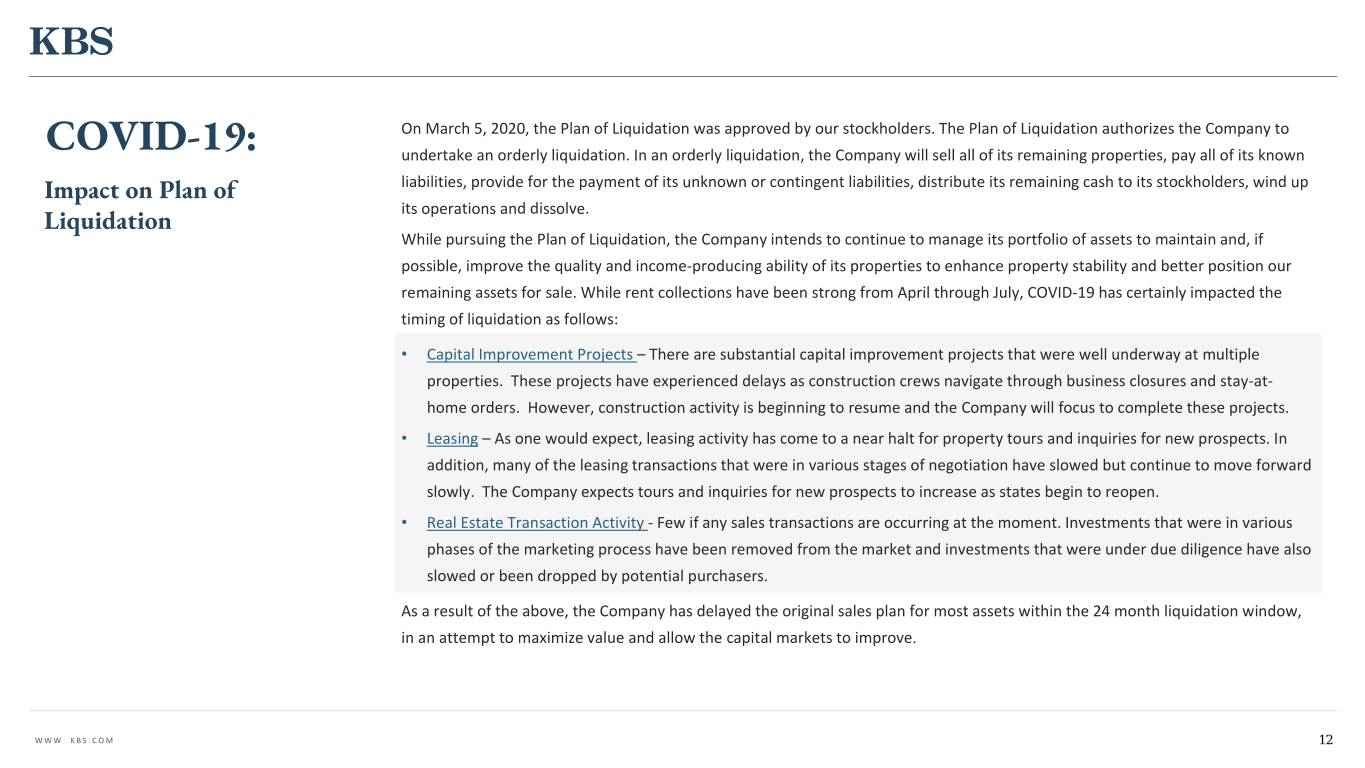
On March 5, 2020, the Plan of Liquidation was approved by our stockholders. The Plan of Liquidation authorizes the Company to COVID-19: undertake an orderly liquidation. In an orderly liquidation, the Company will sell all of its remaining properties, pay all of its known Impact on Plan of liabilities, provide for the payment of its unknown or contingent liabilities, distribute its remaining cash to its stockholders, wind up its operations and dissolve. Liquidation While pursuing the Plan of Liquidation, the Company intends to continue to manage its portfolio of assets to maintain and, if possible, improve the quality and income-producing ability of its properties to enhance property stability and better position our remaining assets for sale. While rent collections have been strong from April through July, COVID-19 has certainly impacted the timing of liquidation as follows: • Capital Improvement Projects – There are substantial capital improvement projects that were well underway at multiple properties. These projects have experienced delays as construction crews navigate through business closures and stay-at- home orders. However, construction activity is beginning to resume and the Company will focus to complete these projects. • Leasing – As one would expect, leasing activity has come to a near halt for property tours and inquiries for new prospects. In addition, many of the leasing transactions that were in various stages of negotiation have slowed but continue to move forward slowly. The Company expects tours and inquiries for new prospects to increase as states begin to reopen. • Real Estate Transaction Activity - Few if any sales transactions are occurring at the moment. Investments that were in various phases of the marketing process have been removed from the market and investments that were under due diligence have also slowed or been dropped by potential purchasers. As a result of the above, the Company has delayed the original sales plan for most assets within the 24 month liquidation window, in an attempt to maximize value and allow the capital markets to improve. WWW. KBS.COM 12

Pursuant to the Plan of Liquidation, the Board of Directors approved an initial liquidating distribution of $0.75/share to Liquidation Approval stockholders of record at the close of business on March 5, 2020 which was paid on March 10, 2020. We anticipate making & Liquidating liquidating distributions to stockholders periodically as we complete asset sales and pay out the net proceeds of such sales. We expect to pay multiple liquidating distribution payments to our stockholders during the liquidation process and to pay the final Distribution liquidating distribution after we sell all of our assets, pay all of our known liabilities and provide for unknown liabilities. On March 5, 2020, at the annual The Company adopted the liquidation basis of accounting as of and for the periods subsequent to February 1, 2020. Net assets shareholders’ meeting, the Company’s in liquidation represents the remaining estimated liquidation value available to stockholders upon liquidation. Due to the shareholders approved the Plan of uncertainty in the timing of the sale of the Company's remaining real estate properties and the estimated cash flows from Liquidation. Based on the range in operations, actual liquidation costs and sale proceeds may differ materially from the amounts estimated. estimated value per share as of November Estimated Net Assets in Liquidation June 30, 2020 March 31, 2020 13, 2019 and the estimated cost and Real Estate $4.36 $4.75 expenses of liquidating the Company, the estimated range in liquidation proceeds Other Assets 0.42 0.10 per share as indicated in the Company’s Total Assets $4.78 $4.85 definitive proxy statement filed with the Notes Payable $1.30 $1.30 Liabilities for estimated costs in excess of estimated receipts during SEC was $3.40 and $3.83 (or $2.65 and 0.66 0.73 liquidation $3.08 after adjusting for the initial Liabilities for estimated closing costs and disposition fees 0.10 0.11 liquidating distribution of $0.75/share)1. Other Liabilities 0.05 0.05 1 See the Company’s definitive proxy statement filed with the Total Liabilities $2.11 $2.19 SEC on December 9, 2019 for information on the calculation of range of liquidating distributions. Estimated Net Assets in Liquidation $2.67 $2.66 WWW. KBS.COM 13

Corporate Technology Centre Two Building Sale 100 Headquarters and 200 Holger Buildings Sale • 100 Headquarters and 200 Holger buildings were sold on June 25, 2020 for a sales price of $68.5 million, net of credits. KBS had leased 100% of both Sold 3 Bldgs. in 2018 for $97.4 mm buildings to Raytheon Corporation for approximately 143,000 SF. 3Q19 Fully Leased to NXP • District | 237 (formerly Corporate Technology Centre) was re-branded and repositioned in early 2019 after the vacancy of Ericsson which allowed KBS to Marketing for Lease better position the asset for today’s technology companies. The newly Sold 100 HQ Drive and 200 1Q19 Fully Leased Holger Way on June 25, 2020 branded District | 237 now comprises the three remaining buildings ranging to CDK in size from 75,000 square feet to 100,000 square feet. • In 2019, KBS executed a full-building lease at 250 Holger Way with CDK Global for 76,000 SF and another full-building lease to NXP for 96,500 square feet at 350 Holger Way. • We are currently marketing two of the remaining three buildings for sale. WWW. KBS.COM 14

2nd Liquidating Distribution & Updated Estimated Value Per Share The net proceeds from the two-building sale of Corporate Technology Centre allowed the board to authorize a $0.25 per share second liquidating distribution on July 31, 2020, which was paid on August 7th, 2020. In connection with the authorization of the $0.25 per share second liquidating distribution, the board also approved an updated estimated value per share of the Company’s common stock of $2.41, effective August 7, 2020. The August 2020 estimated value per share is equal to the midpoint of the estimated range of liquidating distributions of $3.40 and $3.83 per share of $3.615 reduced by (i) the authorization of the initial liquidating distribution of $0.75 per share of common stock for March 2020, (ii) an estimated decrease in the net value of the Company’s remaining real estate properties and other net assets held as of June 9, 2020 of $0.21 per share due to the impact of the COVID-19 pandemic on leasing projections, projected rental rates, hold periods and the resulting ultimate estimated impact on sales prices of the real estate properties, and (iii) the authorization of the second liquidating distribution of $0.25 per share of common stock for August 2020. The August 2020 estimated value per share reflects the resulting reduction of the shareholders’ remaining investment in the Company. For a full description of the limitations and assumptions used in the calculation of the August 2020 estimated value per share, see the Company’s Current Report on Form 8-K filed with the SEC on August 3, 2020. WWW. KBS.COM 15

Portfolio Overview As of June 30, 2020 Key Statistics Geographic Diversification2 No. of Assets 5 Total Rentable Sq. Ft. 2,598,301 VA Cost Basis $931.0 Million 16% CA 37% Wtd Avg Lease Term 6.3 years AZ Economic Occupancy 77.8% 22% 1 Leased Occupancy 79.1% CO No. of Tenants 89 25% Leverage 34% Occupied SF Expirations as of June 30, 2020 Leased Occupancy1 700,000 100.0% 600,000 100% 86.1% 81.4% 500,000 24% 24% 75% 60.7% 63.4% 400,000 50% 300,000 25% Occupied SF SF Expiring Occupied 200,000 10% 6% 0% 4% 5% 5% 6% 100,000 4% 4% 2% 4% Fountainhead Plaza Granite Tower Union Bank Plaza Willow Oaks Corporate Tech 2% Centre 0 1 Leased occupancy includes future leases that had been executed but had not yet commenced as of June 30, 2020. 2 Based on occupied square feet as of June 30, 2020. WWW. KBS.COM 16
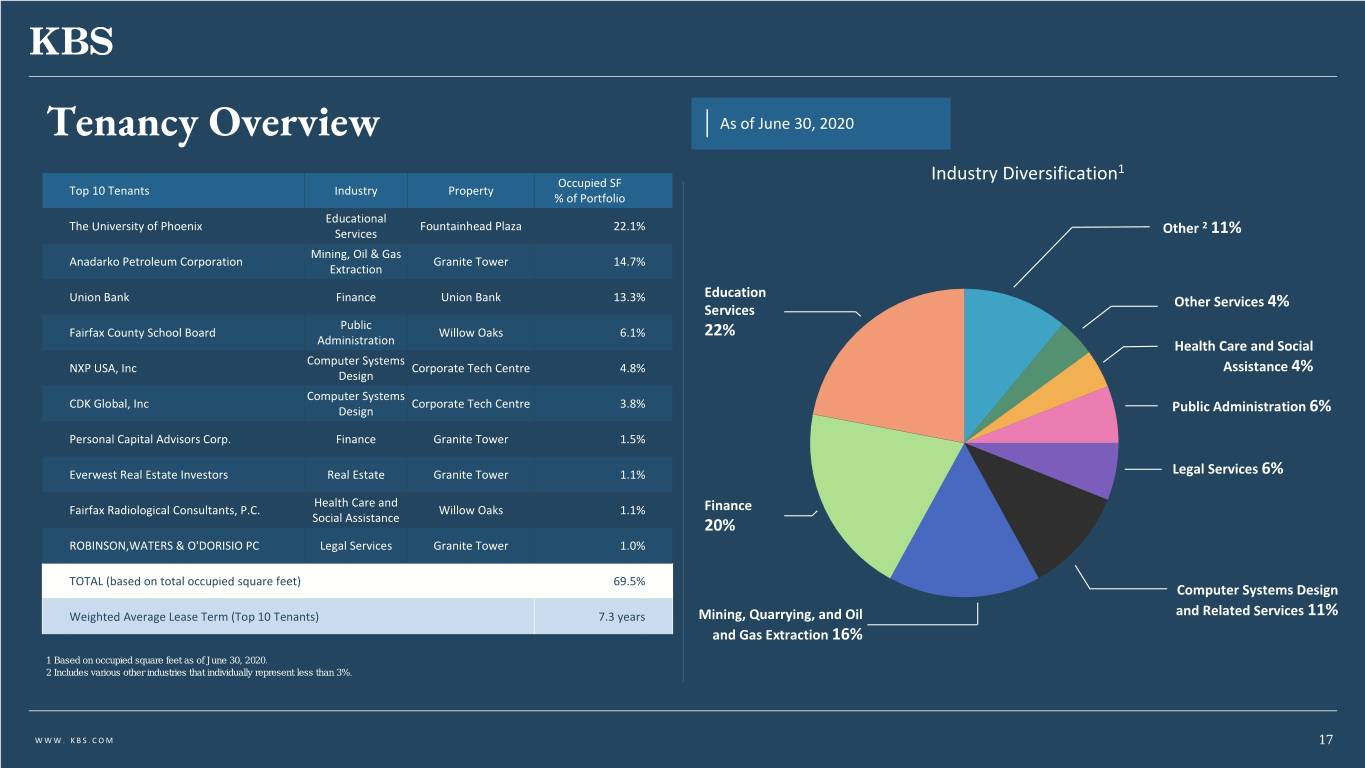
Tenancy Overview As of June 30, 2020 1 Occupied SF Industry Diversification Top 10 Tenants Industry Property % of Portfolio Educational The University of Phoenix Fountainhead Plaza 22.1% 2 Services Other 11% Mining, Oil & Gas Anadarko Petroleum Corporation Granite Tower 14.7% Extraction Education Union Bank Finance Union Bank 13.3% Other Services 4% Services Public Fairfax County School Board Willow Oaks 6.1% 22% Administration Health Care and Social Computer Systems NXP USA, Inc Corporate Tech Centre 4.8% Assistance 4% Design Computer Systems CDK Global, Inc Corporate Tech Centre 3.8% Design Public Administration 6% Personal Capital Advisors Corp. Finance Granite Tower 1.5% Everwest Real Estate Investors Real Estate Granite Tower 1.1% Legal Services 6% Health Care and Fairfax Radiological Consultants, P.C. Willow Oaks 1.1% Finance Social Assistance 20% ROBINSON,WATERS & O'DORISIO PC Legal Services Granite Tower 1.0% TOTAL (based on total occupied square feet) 69.5% Computer Systems Design Weighted Average Lease Term (Top 10 Tenants) 7.3 years Mining, Quarrying, and Oil and Related Services 11% and Gas Extraction 16% 1 Based on occupied square feet as of June 30, 2020. 2 Includes various other industries that individually represent less than 3%. WWW. KBS.COM 17

Liquidation Timeline Obtain Shareholder vote on liquidation - completed on March 5, 2020. Made 1st & 2nd liquidating distributions in March and August 2020 Continue to execute liquidation during 2020 and 2021, making periodic liquidating distributions Complete liquidation within 24 months from March 5, 2020, the day our stockholders approved the Plan of Liquidation. WWW. KBS.COM 18
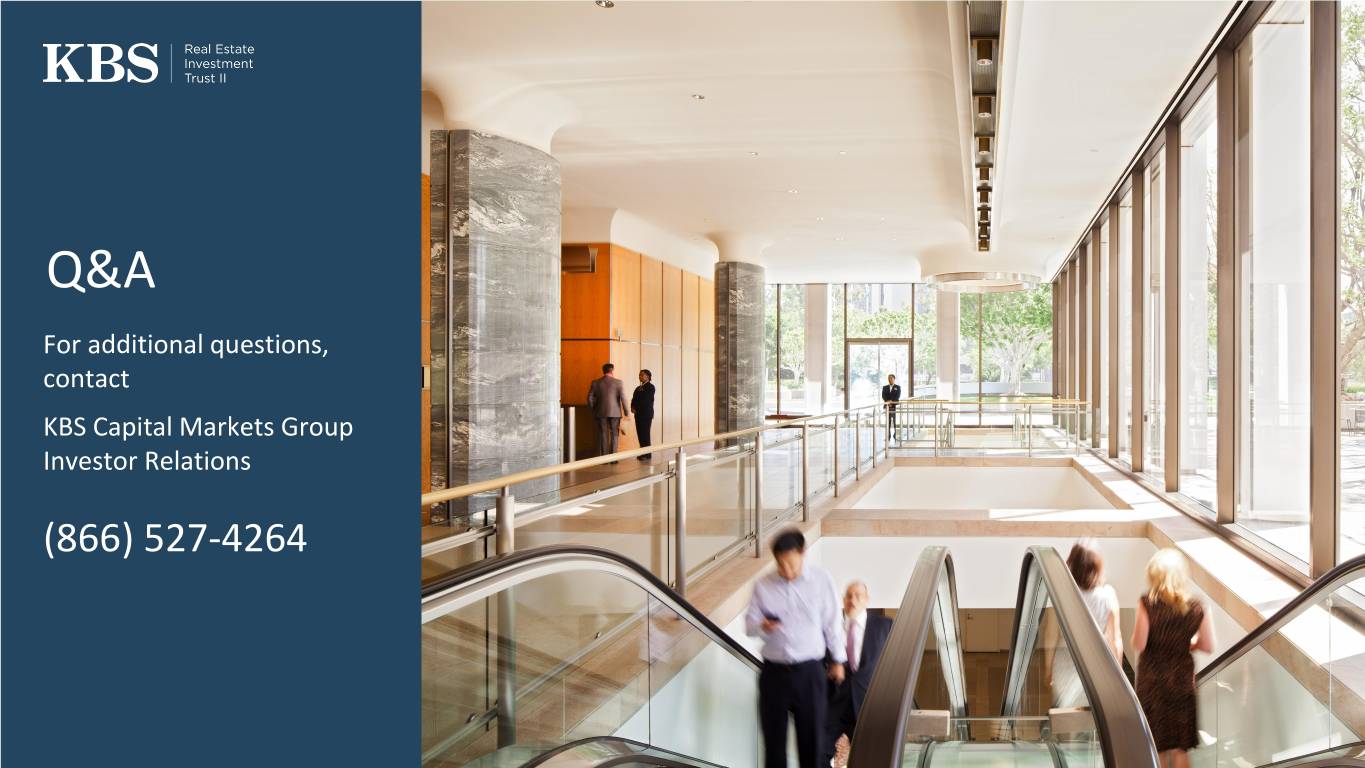
Q&A For additional questions, contact KBS Capital Markets Group Investor Relations (866) 527-4264 19
